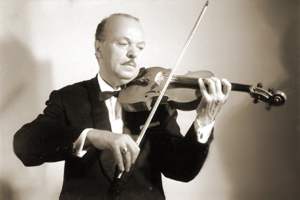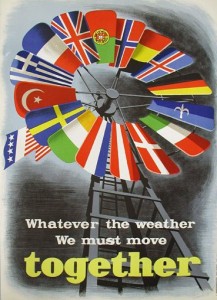How many songs can you think of that have linked traditional music – in this case the Liscio of Romagna – with artists and personalities as diverse as Gloria Gaynor, Jovanotti, Laura Pausini and Pope John Paul II?
There’s only one, that I know of, and it’s the 1954 classic Romagna Mia by the Secondo Casadei Orchestra – a song that continues to top the most-played list in dance halls throughout Italy (and wherever Italians and Romagnoli gather abroad, from Buenos Aires through to Sydney, from New York to Beijing).
When the song celebrated its fiftieth birthday back in 2004 it was an item for the national newspapers. The song has a website dedicated to it, and a number of books have been written on it.
Recently someone gave me a copy of the beautifully presented Romagna Mia Passato e presente di una canzone tra la provincia e il mondo which goes a long way to explaining the importance of the song, and its enduring popularity, mixing documentary material and commentaries alongside a beautiful collection of photos from the modern-day Riviera’s dancehalls.

Secondo Casadei - the Romagnolo Strauss
The story starts with Secondo Casadei, the so-called ‘Romagnolo Strauss’, born on the 1st of April in the small town of Sant’Angelo di Gatteo , son to a well-to-do tailor. On leaving school Secondo was expected to become a tailor alongside his father, but instead by 1924 he was playing second violin in the Emilio Brighi band – one of the many dance bands popular at the time. By 1928 he had formed his own orchestra, which in time would be passed on to his nephew Raoul, and which is still going strong today under the leadership of Raoul’s son Mirko.

The Marshall plan ushered in economic reconstruction
The story of ‘Romagna Mia‘ though dates back to that post-war period, when Italy, and in particular the Riviera, was rebuilding itself. The allied occupation, which in Rimini continued through until 1947, had brought with its soldiers, chocolate, nylon-stockings, jazz and be-bop, as well as the Marshall plan, the Bretton Woods conference and the stepping stones for what would become ‘il boom‘ as the Italian economic miracle of the late 1950s became known.
The riviera from 1947 had been open for business, albeit in a drastically reduced manner from its heyday when it was known as the Riviera del Sole. Each season, though, saw tourism growing, and with it the wish to party, to dance, to forget. It was against this background that the Secondo Casadei Orchestra recorded and performed live.
Casadei was a proud proponent of various styles of music, but in particular the liscio – a dance that’s a combination between a waltz, a polka and a mazurka. The dance was invented in Romagna at the turn of the twentieth century by Carlo Brighi (known as zaclén, or ‘the duckling), and rapidly became popular.
Romagna Mia, perhaps the most famous song in the genre, according to legend, was almost an afterthought. Going into record a disc in Milan Casadei short a song presented something he’d been working on for some time, entitled Casetta mia (my beautiful home). On hearing it, one of the record company heads, Dino Olivieri (who wrote Tornerai/J’Attendrai) turned to Casadei and said ‘ Casadei, why ‘casetta mia’? You’re a romagnolo through-and-through, call it ‘Romagna Mia'” – and the rest, as they say, is history.
This song that is at once local, and proudly provincial (like Fellini’s Amarcord), came along at just the right moment, when people wanted to be happy, to dance, and to recognise something of themselves in the sound. It went on to conquer the whole country and become an anthem that is both global and provincial.
An anecdote told by Cardinal Ersilio Tonino shows how the song’s infectious rhythm and tone swept up one particular visitor to Romagna, Pope John Paul II. On a Papal visit to Forli John Paul II heard the song and was delighted by it – on his return to Rome one of Tonino’s fellow Cardinals rang him to ask ‘what have you done to the Pope? He just keeps singing Romagna Mia!’
It’s little surprise that John Paul II was touched by the song, as its emphasis is on nostalgia and longing, something that can be identified with by all people far from home (he apparently switched Romagna for Polonia in his own version).
It’s perhaps that nostalgia mixed with the unabashed rhythms of the Liscio orchestra. Italian songwriter Jovanotti – who, while being from Milan, has a long history of association with Rimini and the Riviera – when asked to explain the success of Romagna Mia cited the Brazilian Vinicius De Moraes who wrote of Samba:
It’s better to be happy than sad, happiness is the best thing that exists, it’s like a sun inside your heart, but if you want to make a samba beautiful, you need a little bit of sadness too, otherwise a samba is not beautiful
Jovanotti went on to say “The Romagna in this song is the world from out of which we all come, the womb of our Mothers, and where in certain moments you really feel like returning”.
It’s fans have included Ennio Morricone, Gianni Morandi, Rita Pavone, Fiorello, and those late great giants of Italian post-war culture Enzo Biagi and Mike Bongiorno. It was a song that helped define the Riviera, Romagna, and Italy – an emotion to cling to between the destruction of the Second World War and the transformative economic boom of the late 50s, and it’s going as strong as ever – if you don’t believe us, check out this video of Laura Pausini (herself a romagnola) below: